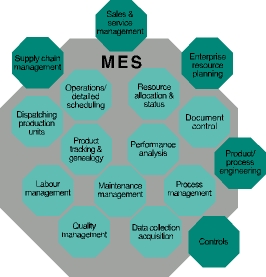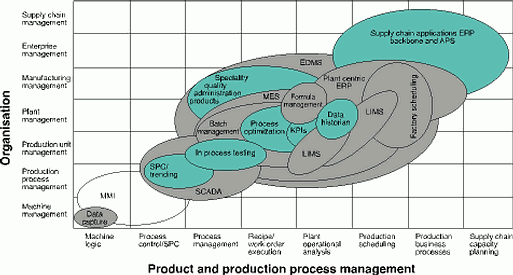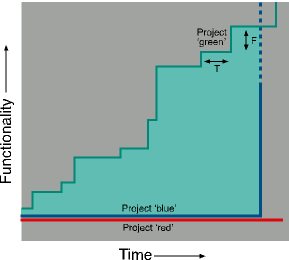

Rome was not built in a day and, apparently, neither are manufacturing execution systems. Rome, however, may have cost less. As manufacturers have discovered worldwide, the implementation of MES can be an extremely expensive and lengthy process. So much so that they can become obsolete during their implementation. Perhaps that is the reason why MES has not had the global buy-in of other initiatives. Today, manufacturers want ROI and business benefits now.
Imagine that, instead of the atom, the basic building block of the universe was the brick. Now imagine trying to make a wristwatch. Monolithic software systems and solutions tend to have the same flexibility. ERP, MES, CIM and many other acronyms all point at software systems because software systems are what a vendor-driven world is all about. Software vendors like systems because they can build compatible functions that are then called integrated. Clients like integrated systems because it means that their functions talk to one another and that purchasing such a system will protect their investment and improve ROI. Open systems are nice but not as nice as integrated systems - in fact, an open system is simply one vendor's acknowledgement that there are other vendors out there with whom his client likes to do business and that he would not sell anything if he could not talk to them - however tenuously (eg, bar codes and CSV (comma separated value) files.)
It has been found, however, that systems have to be tweaked, customised and otherwise beaten into submission if they are to prove worthwhile to their owners. And this customisation never stops. Take an accounting system as an example. You can get money, spend it or stash it somewhere - these are seemingly not very complex processes. Granted that there can be various sources and destinations for each activity, why is it that no one seems satisfied with their 'money management' systems half a century after they were started? Accounting systems, after all, were among the first to be computerised commercially yet many major money earners today are those consulting companies and system integrators that bend accounting systems to meet the needs of their clients - proof positive that systems are not the answer and that their component parts (functions) are.
MES is a collection of functions defined by people who know about these things and that tie shop floor systems to production and business systems. There is no reason why the MES functions shown in Figure 1 should not be implemented incrementally, one at a time. The software system development community, however, immediately turned the functions that the MES acronym inventor specified (atoms) into a system (brick). But some MES functions are fulfilled by ERP systems while others are supported by scada, batch control, OEE (overall equipment effectiveness) and other applications. So, there is no point in imposing the demands of a monolithic MES 'system' on an environment that may already be halfway there.

Figure 2 shows an attempt to impose vendor and acronym-driven systems on the underlying reality of a working manufacturing environment. If this is an attempt to put order into chaos, perhaps chaos is not such a bad idea. Any company that was structured along these lines would be achieving what, exactly? What comes in, what goes out and where is the wealth created? It is not at all obvious. Companies are not defined by acronyms but by well-defined processes (functions) that turn inputs into outputs - raw material to inspected raw material, production schedule to finished goods, broken machine to working machine, etc. These are the functions that need automation, customisation and inter-linking to suit each company's requirements and they do nt need to be merged into mega systems to be valuable.

Imagine not drawing up a shopping list because you do not know what is available at the supermarket. Your shopping spree consists of getting one of everything that is on the shelves. When you get back home, you make a list of what you have which then becomes your shopping list. In turn, the list dictates what you can and cannot cook, what kind of washing machine you should use in the future and that you need to trade in your dog for a cat because the supermarket only stocks cat food. This is the vendor-driven approach to solution selling. Now imagine making a list of your exact requirements and then going back to the same supermarket. It will no doubt be able to satisfy some of your needs and you may have to compromise here and there, but you will have to look elsewhere to complete your shopping list (especially since you are allergic to cats). The important thing to recognise is that your needs are senior to what someone else decides they should be. This is the customer approach to buying and reflects the mood of today's professional manufacturers.
These manufacturers spend a lot of time structuring their wealth creation processes (the reason why the company was created in the first place) and their wealth generating processes (marketing, sales, CRM) as well as all the support processes necessary for their success (information, administration, finance, etc). These interlinked processes are the company and represent a single structure that is trying to achieve its objective of profitable client need satisfaction the best way it knows how. Then they make a shopping list of the solutions they need to help them get there, only to discover that no single vendor or approach can meet them all. This is not really surprising since system vendors cannot be all things to all men (in spite of what their literature may say). For example, a platinum refinery has little in common with an animal feed mill. Both companies are structured and carry out business in very different ways - yet, in the detail; they have many sub-processes in common (eg, process control, production planning, logistics, invoicing, access control, etc). These sub-processes (functions), however, differ significantly between the two companies in their requirements and importance. For example, with platinum at nearly US$1000 an ounce, the refinery is justifiably twitchy about its access control procedures (which not only must manage physical access but computer access as well) whereas the feed mill can spare the occasional bag of dog food (what you have been looking for all along). System software vendors may leave the 'tweaking' of their systems to suit specific requirements to system integrators.
So, let us assume that all the functions (not systems) that any business may require have already been written but need customisation. What is the problem? The problem is when someone tries to 'glue' a certain bunch of functions together to coin yet another acronym and to make bricks out of atoms. The new acronym is touted as being THE way forward. The fact that all its functions will take years and millions to implement and customise, rarely forms part of the sales literature.
Why not have saved time in the early fifties, when all this started, and coined the mother of all acronyms? - ACNATS (all companies need all this stuff). The system would include all the software any company would need to be successful (at least this would make more sense than the confusion of Figure 2). Implementation time, as well as the cost, would be infinite because, by the time you got there, things would have changed (if you managed to stay in business at all in spite of all the help you were getting). That is not the way the real world works. The real world evolves incrementally. So do companies. Solutions have to map to this fundamental principle - not the other way around.
If you look at survey results asking people to quantify the benefits they have realised from the implementation of, for example, MES functions, principles and procedures, it is a fair bet that you will find glowing statements of success. And it is no wonder. MES has made people think about their business in a more holistic way and focus on those processes that generate wealth. The result is greater productivity and improved ROI. The same holds true for the other acronyms. But if you ask about the pain and expense involved to get there, you may get a different reply. It could be said that, in the future, vendor-driven conglomeration of functions systems (MES or otherwise) will play less of a role while rapid, fragmented function implementations will become the preferred way to go.
Figure 3 shows three types of approaches to projects. Project 'Red', (bottom of the chart), took so long in its implementation that scrapping it is the nearest its owner will get to a decent ROI.

Project 'Blue' took a significant time to develop and yielded proportionately significant results. However, much of its functionality was lost because it was developed to conform to criteria that have since changed. So there is likely to be yet another lengthy and costly development cycle for project 'Blue'. By perseverance and money alone, it will eventually get there. Then comes the trick of staying there.
Project 'Green', on the other hand, along with its companions, took very little time to define and complete, yielding proportional functionality and ROI. It involved little risk, could be redefined and redone without raising corporate hell if necessary and was exactly what the enterprise needed at that time. The shaded area indicates the ROI difference between fragmented and monolithic approaches to solution implementation.
"The benefits of this approach are obvious", you will say. "Not at all," will reply your IT manager. "The proliferation of this kind of unstructured software will lead us back to the dark ages of computing and to a major crash down the road!" He is right, of course. All this has happened before and it is happening now. We have come full circle. Structured software development and deployment are obviously correct while unstructured and rapid solutions make more business sense.
The implementation of an MES system can be costly, lengthy and traumatic. Yet the implementation of its component parts as and when required is a far more rewarding exercise. What is needed is an environment that will allow this newly emerging reality to materialise within the framework of IT disciplines while catering for the business benefits that can be realised through rapid and low-cost implementations.
Today, we have tools that address these fundamental needs. Because that, after decades and decades, is what it has come down to. No more mega projects, no more dictates from the gurus of the industry - simply working solutions on demand that provide continuous and incremental process improvements. Wonderware's industrial automation architecture, called ArchestrA and its Industrial Application Server, provide an environment for integrating disparate solutions and databases that were created on demand, irrespective of their source.

For more information contact Mike le Plastrier, Futuristix Advanced Control Systems, 011 723 9900, [email protected], www.futuristix.co.za
The MESA International definition for MES is:
"Manufacturing execution systems (MES) deliver information that enables the optimisation of production activities from order launch to finished goods. Using current and accurate data, MES guides, initiates, responds to and reports on plant activities as they occur. The resulting rapid response to changing conditions, coupled with a focus on reducing non value-added activities, drives effective plant operations and processes. MES improves the return on operational assets as well as on-time delivery, inventory turns, gross margin, and cash flow performance. MES provides mission-critical information about production activities across the enterprise and supply chain via bi-directional communications."

© Technews Publishing (Pty) Ltd | All Rights Reserved